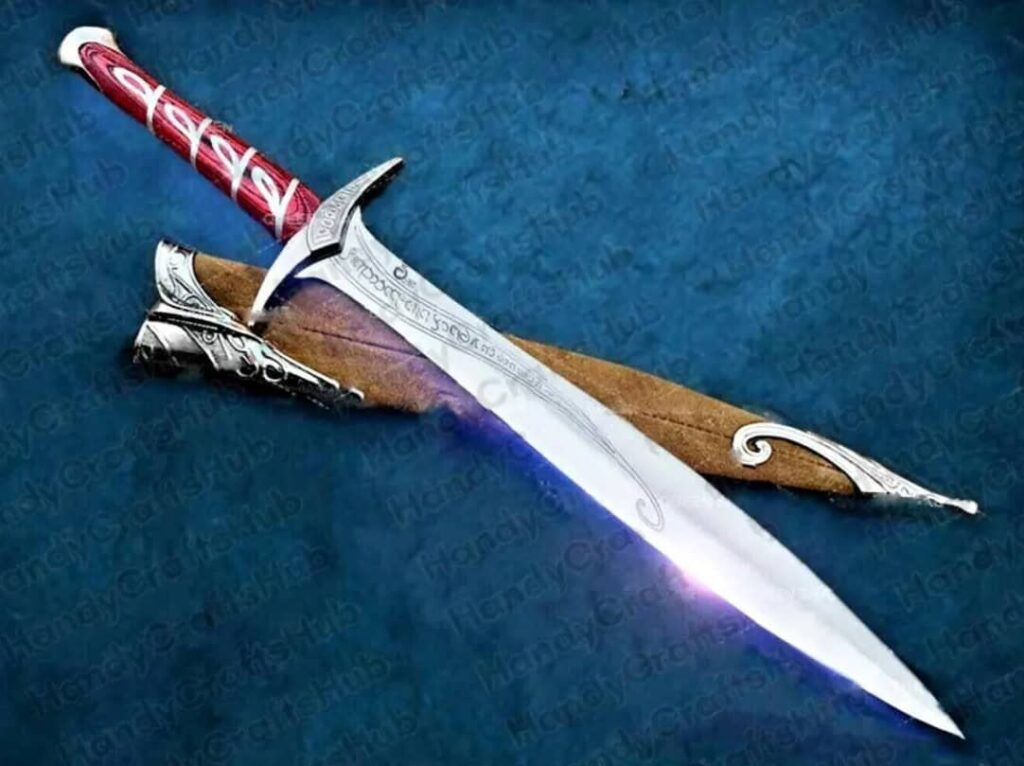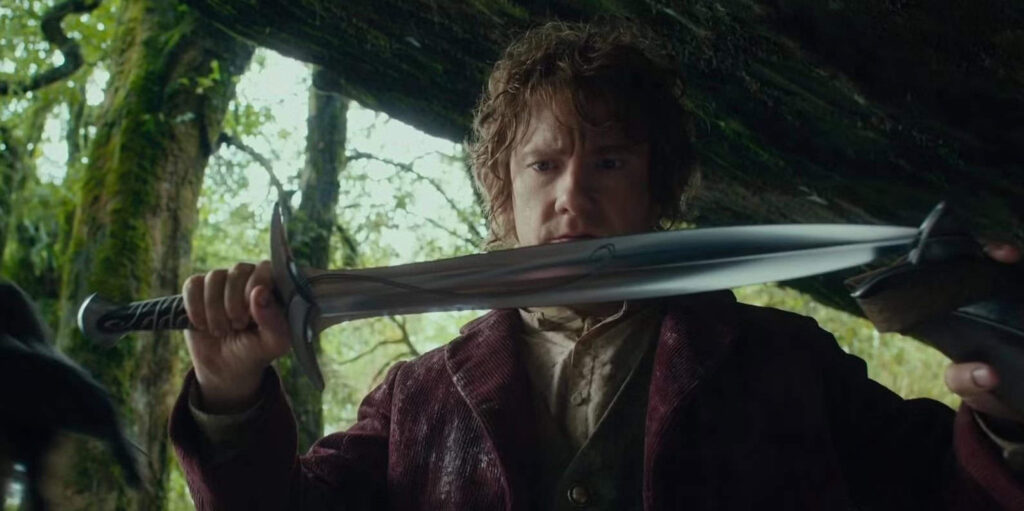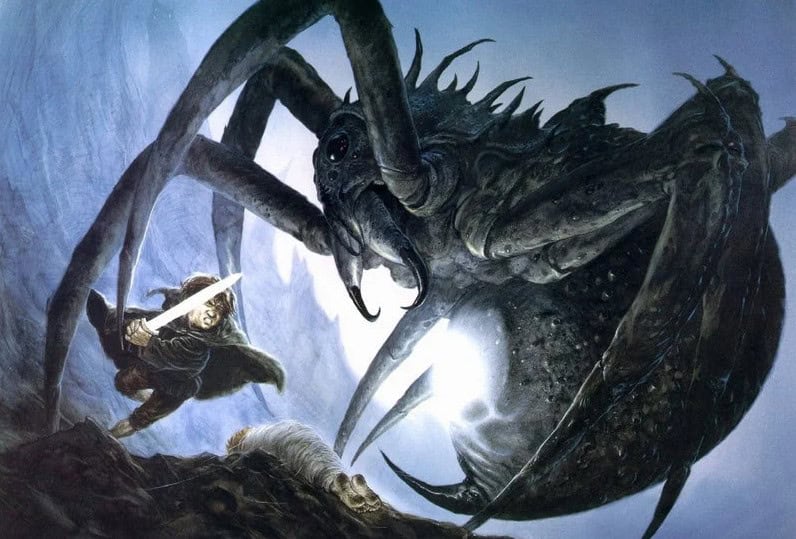The History of Sting in Lord of the Rings
TLDR: Sting, a magical Elven blade discovered by Bilbo and later wielded by Frodo and Sam, played a pivotal role in The Lord of the Rings saga, aiding the Fellowship with its orc-detecting glow and unmatched sharpness throughout their journey.
When I first encountered Sting in The Hobbit, I knew this wasn’t just any ordinary blade. This small but mighty sword has captured my imagination ever since, weaving its way through the epic tales of Middle-earth like a shining thread of hope. From its mysterious origins in the ancient elven city of Gondolin to its crucial role in the quest to destroy the One Ring, Sting’s journey is as fascinating as the hobbits who wielded it. I’ve always believed that Sting is more than just a weapon – it’s a symbol of courage, a beacon in dark places, and a testament to the unexpected strength found in the smallest of heroes.
Origins of Sting
Sting, the legendary blade that played a crucial role in the adventures of Bilbo and Frodo Baggins, has a rich history rooted in the ancient Elven city of Gondolin. Forged during the First Age by skilled Elven craftsmen, Sting exemplifies the pinnacle of Gondolin’s weaponsmithing prowess. The exact date of its creation remains unknown, but it’s believed to have been crafted alongside other famous blades like Glamdring and Orcrist.
The original purpose and owners of Sting are shrouded in mystery. Given its small size compared to typical Elven swords, it’s likely that Sting was designed as a dagger or short sword for close combat situations. Some speculate that it may have been crafted for a young Elven noble or as a ceremonial weapon. However, without concrete evidence, these remain educated guesses at best.
Sting’s journey from Gondolin to the troll hoard where Bilbo discovered it is a tale of survival and chance. When Gondolin fell to Morgoth’s forces in the First Age, many of its treasures were lost or scattered. Sting, along with Glamdring and Orcrist, somehow survived the city’s destruction. These blades likely changed hands multiple times over the centuries, passing through various owners before ending up in the possession of the trolls.
The path that led Sting to the troll hoard could have included:
- Salvage by survivors fleeing Gondolin
- Trade between Elven realms
- Acquisition by human warriors or nobles
- Theft by opportunistic bandits or creatures
- Collection by wandering treasure hunters
While we can’t know the exact route Sting took, its presence in the troll hoard speaks to the enduring quality of Elven craftsmanship. Despite centuries of potential misuse or neglect, the blade remained intact and retained its magical properties.
Sting’s Discovery by Bilbo
The discovery of Sting by Bilbo Baggins marks a pivotal moment in both the hobbit’s journey and the blade’s history. This fateful encounter occurred during Bilbo’s adventure with Thorin’s company, specifically after their run-in with three trolls in the Trollshaws.
After Gandalf cleverly tricked the trolls into arguing until dawn, turning them to stone, the company explored the trolls’ nearby cave. Within this hoard, they discovered a variety of weapons and treasures. While Gandalf and Thorin claimed the more prominent swords Glamdring and Orcrist respectively, Bilbo’s attention was drawn to a smaller blade. This knife, which would later become known as Sting, was of Elvish make but went unnoticed by the others due to its size.
Upon reaching Rivendell, Elrond played a crucial role in identifying the blades found in the troll hoard. While he provided detailed information about Glamdring and Orcrist, including their names and origins from the ancient city of Gondolin, Sting’s specific history remained a mystery. Bilbo, perhaps due to his modest nature or simply not realizing its significance, did not present Sting to Elrond for examination. As a result, the blade’s original name and full history were never revealed.
The initial reactions to Sting’s properties were not immediate, as its most notable feature – the ability to glow blue in the presence of orcs or goblins – was not discovered until later in Bilbo’s journey. However, even without this knowledge, Bilbo quickly realized the blade’s exceptional qualities:
- Sharpness beyond that of ordinary weapons
- Lightweight design, perfect for a hobbit’s use
- Elegant Elvish craftsmanship
Sting’s Journey with Bilbo
Sting’s journey with Bilbo Baggins marked a significant chapter in the blade’s history, transforming it from an unnamed Elvish knife to a legendary weapon. The blade’s true potential was first realized in the dark and treacherous forest of Mirkwood, where Bilbo and his Dwarf companions faced one of their most harrowing challenges.
In Mirkwood, Bilbo encountered giant spiders that had captured and cocooned his Dwarf companions. It was here that Sting saw its first real combat use. Bilbo, finding courage he didn’t know he possessed, used the blade to free himself from the spiders’ webs and then to attack his arachnid foes. The Elvish blade proved remarkably effective against the spiders, slicing through their tough exoskeletons with ease. This encounter not only showcased Sting’s capabilities but also marked a turning point in Bilbo’s character development, as he became more confident and resourceful.
It was during this intense battle with the spiders that Bilbo decided to name his blade. Feeling emboldened by his success and the weapon’s effectiveness, he declared, “I will give you a name, and I will call you Sting.” This naming was a significant moment, as it personalized the weapon and cemented its bond with Bilbo. The name “Sting” was particularly apt, given how the blade had just been used to repeatedly sting the giant spiders.
While the books don’t provide explicit details about Sting’s role in the Battle of Five Armies, we can make some informed assumptions based on the context:
- Defensive weapon: Sting likely served as Bilbo’s primary means of defense during the chaotic battle.
- Orc detection: Its ability to glow blue in the presence of orcs would have been invaluable in the heat of battle.
- Morale boost: Wielding an Elvish blade may have bolstered Bilbo’s courage during the intense conflict.
Magical Properties of Sting
The most notable and visually striking property of Sting is its ability to glow blue in the presence of orcs or goblins. This enchantment serves as an early warning system for its wielder, alerting them to nearby dangers. The intensity of the glow appears to correlate with the proximity and number of orcs, providing valuable tactical information. Interestingly, this glow may also extend to other evil creatures, as evidenced by its reaction to the giant spiders of Mirkwood.
Sting’s enhanced cutting ability is another of its remarkable features. The blade demonstrates an uncanny sharpness that surpasses that of ordinary weapons, allowing it to slice through materials that would typically resist conventional blades. This property was particularly evident when Frodo used Sting to effortlessly cut through Shelob’s webs, a feat that Sam’s Barrow-blade could not accomplish. Additionally, during the Battle of the Chamber of Mazarbul, Sting proved capable of wounding a cave troll, while Boromir’s sword merely glanced off its hide.
The durability and resistance to wear exhibited by Sting is truly exceptional. Despite its age and the numerous battles it has seen, the blade shows no signs of dulling or damage. This resilience is a testament to the superior craftsmanship and magical enchantments of the Elves of Gondolin. Sting’s ability to maintain its edge and structural integrity over centuries of use and periods of inactivity speaks to the enduring nature of Elvish magic.
Sting’s Transition to Frodo
The transition of Sting from Bilbo to Frodo marks a pivotal moment in the history of this legendary Elvish blade. This transfer occurred in Rivendell in T.A. 3018, just before the Fellowship of the Ring embarked on their perilous journey to destroy the One Ring.
Bilbo’s decision to gift Sting to Frodo was a deeply significant act. As Bilbo prepared Frodo for the dangers ahead, he presented him with two invaluable items: his mithril coat and Sting. The gifting of Sting was accompanied by Bilbo’s poignant words: “My old sword, Sting. Here, take it, take it!” This moment symbolized not just the passing of a weapon, but the transfer of a legacy and the torch of adventure from one generation to the next.
The significance of this transfer cannot be overstated. For Frodo, receiving Sting represented:
- A tangible connection to Bilbo’s adventures
- A powerful tool for the challenges ahead
- A symbol of trust and faith from his uncle
Sting’s transition to Frodo also marked a new chapter in the blade’s own journey. Having served Bilbo well in his adventures, it was now poised to play a crucial role in an even more momentous quest. The sword’s ability to glow blue in the presence of orcs would prove invaluable to Frodo, serving as both a weapon and a warning system throughout his journey.
To understand the full impact of this transition, consider the following comparison:
| Aspect | With Bilbo | With Frodo |
| Primary Use | Adventure and self-defense | Quest to destroy the One Ring |
| Enemies Faced | Spiders, Gollum | Orcs, Nazgûl, Shelob |
| Symbolic Meaning | Personal growth | Hope and perseverance |
Sting’s Role in the Fellowship’s Journey
Sting played a crucial role throughout the Fellowship’s perilous quest, serving not only as a weapon but also as a warning system and a symbol of hope. Its significance was particularly evident during key moments of the journey, including the passage through Moria, encounters with Gollum, and the battle with Shelob.
In the mines of Moria, Sting’s unique ability to glow blue in the presence of orcs proved invaluable. As the Fellowship navigated the dark and treacherous passages, the sword’s luminescence alerted them to impending danger. This early warning system allowed the group to prepare for encounters with the numerous orcs inhabiting the ancient dwarven city. Notably, during the intense battle in the Chamber of Mazarbul, Frodo used Sting to strike a cave troll, demonstrating the blade’s effectiveness even against larger foes.
Sting played a significant role in Frodo’s interactions with Gollum. The sword’s elvish nature and reputation struck fear into the heart of the corrupted creature, who had a deep-seated aversion to anything of elvish make. This fear became a tool for Frodo, allowing him to assert some control over the unpredictable Gollum. During their first encounter, Frodo used Sting to force Gollum into submission, compelling him to guide them through the Dead Marshes and towards Mordor.
The battle with Shelob in Cirith Ungol marked one of Sting’s most pivotal moments in the journey. After Frodo was paralyzed by Shelob’s venom, Sam took up Sting and used it to great effect against the monstrous spider. The elvish blade proved remarkably effective, able to pierce Shelob’s tough hide where other weapons might have failed. Sam’s use of Sting in this battle not only saved Frodo’s life but also added to the sword’s legendary status.
Throughout these encounters, Sting demonstrated various capabilities:
- Orc detection through its blue glow
- Effective against a wide range of enemies, from orcs to giant spiders
- Psychological weapon against creatures like Gollum
- Symbol of elvish craftsmanship and heroic legacy
Sam’s Wielding of Sting
Samwise Gamgee’s acquisition and use of Sting marked a crucial turning point in the quest to destroy the One Ring. The circumstances under which Sam came to wield Sting were both tragic and heroic. After Frodo was paralyzed by Shelob’s venom in the pass of Cirith Ungol, Sam believed his master to be dead. In this moment of crisis, Sam made the difficult decision to take the Ring and continue the quest. Along with the Ring, he also took Sting from Frodo’s seemingly lifeless body, recognizing the blade’s importance for the journey ahead.
Sam’s use of Sting against the orcs in Mordor demonstrated the weapon’s effectiveness and its significance as a symbol of hope. As Sam made his way through the Tower of Cirith Ungol to rescue Frodo, Sting proved invaluable. The blade’s blue glow warned Sam of nearby orcs, allowing him to navigate the dangerous territory more safely. In one notable instance, an orc caught sight of Sam’s shadow on a wall, but the light emanating from Sting made Sam appear as a great and terrible warrior, causing the orc to flee in fear.
The return of Sting to Frodo occurred after Sam’s daring rescue in the Tower of Cirith Ungol. Once reunited, Frodo initially told Sam to keep Sting for the remainder of their journey, recognizing Sam’s bravery and the blade’s usefulness in his hands. However, it’s implied that Frodo eventually reclaimed Sting, as he was its primary bearer for most of the quest.
Physical Characteristics of Sting
Sting’s size is relatively small compared to full-length swords, befitting its classification as a dagger or short sword. While Tolkien never provided exact measurements, we can infer its dimensions based on descriptions in the text. The blade is short enough for Bilbo to carry it hidden in his breeches, suggesting a length of approximately 10 inches or less. This size made it an ideal weapon for hobbits, being large enough to serve as a short sword for them while remaining a dagger by the standards of Men or Elves.
The shape of Sting is not explicitly described as leaf-shaped in Tolkien’s writings, contrary to some popular depictions. However, its Elven craftsmanship likely gave it an elegant and efficient design. The blade probably featured a double-edge, typical of daggers from the First Age of Middle-earth.
One of Sting’s most distinctive features is its inscriptions and markings. In Peter Jackson’s film adaptation, Sting bears an engraving in Sindarin that translates to “Maegnas is my name, I am the spider’s bane”. While this specific inscription is not mentioned in Tolkien’s original works, it aligns with the Elven practice of naming blades and imbuing them with purpose.
To better understand Sting’s characteristics in comparison to other notable blades:
| Weapon | Type | Size | Notable Features |
| Sting | Dagger/Short Sword | ~10 inches or less | Glows blue near Orcs, lightweight |
| Glamdring | Sword | Full-length | Known as “Foe-hammer”, ancient and powerful |
| Orcrist | Sword | Full-length | Known as “Goblin-cleaver”, feared by Orcs |
Sting’s Journey After the War of the Ring
After the destruction of the One Ring and the fall of Sauron, Sting’s journey continued as it returned to the Shire with its bearers. The legendary blade, having played a crucial role in the quest to save Middle-earth, now faced a more peaceful future.
Upon their return to the Shire, Frodo Baggins still possessed Sting. However, as Frodo struggled with the lasting effects of his wounds and the burden of having carried the Ring, he made the decision to sail to the Undying Lands. Before his departure in September T.A. 3021, Frodo entrusted many of his possessions to Samwise Gamgee, including Sting.
Sam’s ownership of Sting marked a new chapter in the blade’s history. As the last of the Ring-bearers remaining in Middle-earth, Sam kept Sting as a reminder of the great quest and the sacrifices made. The sword likely served him well during the years he spent as Mayor of the Shire, a position he held for seven terms.
The final fate of Sting is not explicitly stated in Tolkien’s works, leaving room for speculation. There are two main possibilities for its ultimate ownership:
- Sam took Sting with him to the Undying Lands
- Sting remained in the Shire as an heirloom of the Gardner family
If Sam did indeed take Sting with him when he finally sailed West in F.A. 61, it would have reunited the blade with its previous bearers, Frodo and Bilbo, in the Undying Lands. This would provide a poetic end to Sting’s journey, bringing it full circle from its creation by the Elves to its return to their realm.
Alternatively, if Sting remained in the Shire, it would have become a treasured heirloom of the Gardner family, passed down through generations as a symbol of Sam’s heroic deeds and the Shire’s connection to the greater history of Middle-earth.
Where Can I Get a Sting Replica?
If you’re looking to add a Sting replica to your collection, there are plenty of online retailers and specialty shops that offer high-quality versions of this iconic blade from The Lord of the Rings. Whether you’re after a detailed full-size replica or a smaller collectible version, you’ll find Sting replicas available through licensed merchandise stores, fan sites, and even auction platforms.
Kult of Athena

HandyCraftsHub

LandonForge

HeritageCraftsCA

Final Thoughts
As I reflect on Sting’s incredible journey through the events of The Lord of the Rings, I can’t help but feel a sense of awe at how this small blade played such a big role in the fate of Middle-earth. From Bilbo’s trolls to Frodo’s confrontation with Shelob, and even in Sam’s brave hands in Mordor, Sting has been there for every critical moment. In my opinion, Sting is the unsung hero of the story, a constant companion that never failed its bearers when they needed it most. As the Third Age came to a close and the hobbits returned to the Shire, I like to imagine Sting hanging above a cozy fireplace, its blue glow a reminder of adventures past and the enduring spirit of those small but mighty heroes who changed the course of history. It certainly deserves a spot among the coolest fantasy weapons in literature and beyond.



